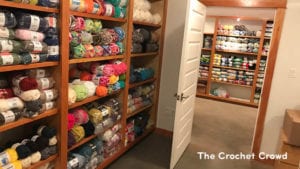
It's been a year since the first North American lockdown when the world came to a screeching halt. Most of us will never forget what we have lived through and the adjustments we have made in our lives.
The lockdown created free time for many people and suddenly hobbies that were thought to being one day I will learn, suddenly became the day to learn.
The pandemic caught manufacturers and retailers by surprise in being prepared for what was next.

What few people consider is the supply chain of product movement. My specialty in my life was logistics. If you have heard my backstory, I worked in courier and then trucking as a driver and then internal office in trucking. I have worked during the Christmas and seasonal rushes over the years and man oh man, it was relentless hell. By the time Christmas came and working right up until Christmas Eve, the last thing I wanted to do is celebrate Christmas. All good wishes and sweetness is thrown out the door when things are delayed. People can be so ignorant to not see the entire picture and only think of their individual needs. The pandemic for me has been groundhog day, day after day.
Don't even get me started on people complaining about slow deliveries. I've been in those worker's shoes! It's anything but joyous.
North America Wasn't Just Locked Down

Being in North America, we often forget we are not the only ones on this planet. When the North American lockdown occurred, regions in the world were already in lockdown up to a month before North America. This halted logistics which included shipping through the ocean, planes and transports.
International shipping started up again when North America was still in lockdown. However, there was a month hole completed but because North America was still in lockdown, the hole wasn't noticed as much. However, North America had a bigger problem.
The Bigger Problem

- With North America locked down and millions of workers bounced out of their jobs.
- With millions more adjusting to working from home or in a limited capacity.
- With staffing being cut due to social distancing concerns. It caused delays and semi-permanent adjustments to having fewer people being allowed to work in the same space.
- This created shortages of people-power to be working in distribution centres and at first, ground to a halt but companies had to figure out how to work in a safe manner but still kept moving.
- There was a lag-time of about a month of no shipping that had already started but was opened again. Not just finished goods but also raw materials that companies rely on.
Manufacturing is considered an essential workplace but manufacturing had to adjust to maintaining safety while doing the job. The yarn industry quickly adjusted while other companies were still trying to figure the future out. Small things we take for granted had to be considered.
While North America is trying to figure out what is going on in the manufacturing, distribution and retail sense. One thing didn't stop, online sales which then created the next biggest wave of problems.
Online Sales The Explosive Wave

The online sales market exploded. With stores being closed completely or shifted to curbside pick up. Online became the primary source of sales.
Online orders blew through the roof across all genres of retail. The problem was behind the scenes with limitations of product movement with reduced staffing.
- Manufacturing was working at a limited capacity which, in some cases, is below their average output.
- This included warehousing in receiving and resorting stock to go back out.
- Reduction of transportation to get the product to move. A truck cannot deliver to a warehouse if the warehouse is on a limited crew and cannot handle the regular volume of the trucks that arrive.
- Courier and mail were seriously backed up with drivers and sorters being limited.
- Government-mandated in the courier and mailing services that essential products are the priority and everything else is delayed.
It compiled into a massive backlog that was felt globally. In fact, I just got a Christmas card 2 weeks ago and it's now April 5th. The backlog is real.
Social Media Backlash

The social media backlash is a part of this story where The Crochet Crowd found ourselves. Heading directly into the eye of the beast.
There were so many really shocking updates on social media. Some people I was just embarrassed for.
As a person who worked in logistics as I mentioned. There is so much that goes on behind the scenes that people rarely think about. When you see a transport driver on the road, chances are they have a load that is destined for a location where the product is off-loaded and then distributed into the manufacturing or retail sector to keep humanity moving forward.

When we look at yarn:
- Raw materials are received from various sources which include global deliveries.
- It takes people to offload trucks and place them in holding at the manufacturing facility.
- The product is made and in many cases, the raw materials are moving around the manufacturing plant before the final ball of yarn is ready.
- Yarn is boxed and in some cases, the boxes are picked up and moved to a holding warehouse that the manufacturer has.
- Orders are received from the retailers and the stock is resorted and skidded into a custom order. In many instances, full trucks are assigned to move a variety of products to another location where it's again holding.
- In the massive retailer chain, they have many distribution centres where the trucks arrive into. From here. The stock is put away and waiting for store assignment and availability on the transport trucks that will take the products to the backdoor of the store.
- The stock at the retailer distribution is resorted again and dedicated store.
- The boxes are reloaded to a truck again and then dropped at the store where staff unbox and place them on the shelf.

Every one of those steps had delays during Covid-19 as it's all people based labour and in social distance facilities, the work slowed down. In some cases, stores were closed and shipping from the distribution to the stores was halted. Causing empty yarn shelves because replenishment wasn't able to be done.
With curbside, only an option for a limited time and trucks being halted for delivering to the stores due to backlog in the steps above, the stores were depleting their stock without getting replenished.
Michaels Canada, for example, doesn't stock online orders from a warehouse. It uses its stores as the stock for online orders. By the time the stores re-opened to the general public here in Canada, the stock was already depleted and new stock was delayed as the trucking to the stores was halted.
The video shows you a perspective behind the scenes showcasing JOANN Fabric and Crafts. See how the yarn will move.
The Bigger Picture

Educators like us were asked to keep the educational platform moving along. This meant to keep a momentum of new patterns, new videos and new articles.
For The Crochet Crowd, it really meant no change for us in the workload but it did have us shift our attention to different priorities than normal.
- Focus more on beginners and beginner-level projects.
- Focus on yarn that we knew wasn't as short.
- Focus on the consistency of timed releases of video tutorials. For Fall 2020, I released 1 tutorial per day for 4 months straight. I wasn't asked to do that but did so because I knew people were home. I was trying to see to the needs of the crocheter.
However, there is still a problem. The delays of the supply chain created a backlash on social media with inflated complaints and stories where people were seriously upset about the delays of shipping and lack of inventory at the stores.
So while we are delivering new content, we have to teeter-totter the backlash and keep communications open and honest. However, for some, the transparency is hoo-haa and not a strong enough excuse for why the stores were empty and stock-taking nearly 2 months to get to a person's home. Some are not thinking about what happens beyond the back doors of the store to see the entire picture in play. To this day, some people still think it's all lies but trust me when I tell you, if a corporation can get some change out of your pocket, they will. So the shortage of yarn is a sales problem which no one wants behind the scenes. Blunt, but true.
For this, we have to look back to 2019 as the problem occurred there, a year earlier.
Projection Was Not Projected

Let me put this in terms you will most understand.
When we decide on a crochet cruise, we project the number of guests that we are expected to have. We start about 2 years prior to having time to build the event and plan. We target a minimum number so we can afford to do the event. The number isn't hypothetical, it's known based on previous results of hosting a crochet cruise. We adjust our projections based on the ship, costs and location of the destination.

Manufacturing and retailing are also done the same way. In one company I worked for, the projection of the winter-based products is known a year ahead of time. It was a weather-driven product where the worst the weather, the better it was for the company I worked for sales but if the weather was really bad, it would create a back-lash of lack of inventory.
- The company knows how many units were made in the years before for each winter and comes up with a projection on how many units need to be ready for the winter.
- If the winter is mild, the projection would be too high (too much stock). If it's a bad winter, the projection would be too low (lack of stock).
The projection is what creates advanced inventory to be ready for a season or year which is decided many months or a year earlier.
How Pandemic Ruined Projections

Covid-19 came out of nowhere and no time to adjust projections before it hit.
The yarn you see on the shelf that just arrives wasn't made last week. It was made at a minimum of a month to up to a year prior. Longer in some cases where the yarn interest isn't high and is slow to sell.
When a brand new product comes out, it is made so many months ahead of time so all stores within a retail chain have time to receive their stock on time and to be loaded to the shelf on a pre-determined date. In Michaels Stores, there are over 1200 stores that need to be stocked at the exact same time if all stores are assigned to receive the product.
JOANN has over 850 stores, again the same issue with all stores (if assigned) needs to be stocked at the exact same time. Factor in Walmart and other chain stores plus independent stores.

To supply thousands of stores, the projections in advance are based on previous shopping experiences to know what we could potentially buy within the year.
Projections for 2020 were already done in 2019 and manufacturing staying on track.
Each store doesn't run out of stock at the same time. The yarn trickles like a leaking faucet and fulfills the needs of the store. Stores that sell faster have a bigger leaking faucet and other stores where yarn doesn't move as quickly have a slower trickle and isn't as much as a priority.
But the pandemic pulled the drain out of the bathtub for the yarn and including so many other products that stores were literally wiped out of stock.
- Online orders were coming in fast and furious wiping out stock inventory.
- Retailers were being wiped out due to an influx of new consumer behaviour.
- Stock reserves bottomed out and all yarn projections for 2020 hit projection levels middle of the year leaving no stock.

What is true, the system of commercial stock replenishment is not designed to restart all stores from scratch. This is not just yarn, it's everything.
You have literally 1000's stores that are wiped out to a minimum to no stock that needs to be replenished at the same time.
Yarn making is intended to be a trickle and manufacturing is set to do that. It's not designed or set up to magically fill stores from scratch with all products at the same time.
So much stock depleted, that inventory being made for 2021 was shifted to be sold in 2020 to try to counterbalance the empty shelves. Fall 2020 saw record lows of stock inventory across the spectrum.
The projection never anticipated a significant uprise of new users of yarn. That's exactly what created the empty shelves and lack of stock.
We Would Have Never Run Out Of Yarn

With the pandemic that hit, people suddenly were turning to things like YouTube for educational instructions. In fact, on The Crochet Crowd, I can see exactly what date the lockdown occurred because of analytical data of video usage and website hits. It would be a turning point that dominos the yarn supply.
People interested in trying a yarn-based hobby where stores were open found themselves looking at the yarn aisles for the first time. The number of new users to the yarn ballooned and blew the projections out of the water. So while the industry projected how much yarn is needed for 2020, the new users due to the pandemic wasn't a known factor. The number of shoppers for the yarn exponentially increased. Sites like ours exponentially increased across our properties. It's what created the empty shelves.
So why does 2021 still have empty yarn shelves anyway?
Yarn in 2021 is in Recovery Mode

As I mentioned above, to compensate for depleted inventory that happened in the middle of the year. Inventory being made for 2021 was pushed ahead to put into the supply chain.
Projections for 2021 were done again after the pandemic hit and adjustments for the new population of yarn users could be made. There was again a problem.
- Stores were already depleted in stock.
- In order to continue to stock for 2020, inventory that is made and intended for 2021 is pushed ahead and put into the supply chain on a real-time basis. Opening the flood gates to get the stores and online shopping back up.
- In the online world, the stock would be sent to the online warehouse suppliers and as soon as the inventory was put into the warehouse and listed as in-stock, the stock was wiped out within days. The online world of shopping was moving faster than the yarn suppliers could handle.
- Stock arriving into depleted stores, same issue as the online stock. New stock arrived and would be wiped out as it's been missing for months.

Pushing stock ahead of time to fulfill 2020 depleted the stock again for 2021 but what changed was the manufacturing rates of pumping more stock out faster than their normal. To essentially, catch up.
With more than normal stock being made now, the goal is to catch up and get the stores back to their regular style. Yes, it can be argued and I see it often in people complaining about their stores never having enough stock even before the pandemic. That's not something I can answer as I am not in the know or part of those decisions.
We Will Start To See a Stock Rebound

By the end of 2021, we are hoping to see the stock rebound back to pre-pandemic levels. I know some of you are like, "Why not now!?"
With 1000's stores to replenish and a lot of consumers changing their experiences to online shopping, the online shopping influx has to be taken into account. Myself, I became an official online shopper in 2020 and continue to maintain this shopping pattern today. In fact, my order from Yarnspirations just arrived last week.
With the vaccination rollouts, more people will head back to work. This will create less free time to explore the yarn arts. That will settle down the yarn sales. This will give the stores more time to keep the yarn on the shelves longer and allow the trickling of the yarn to start filling in the holes on the shelves as it settles down.

However, there are literally 1000's stores that need inventory to get back to normal. There are still millions of people with unwanted free time and wanting to return to a normal routine. For some of us, the re-opening of normal life is still an unknown future for timelines.
What will be true after this is all said and done, there will be far more crocheters than ever before. For the new projections take into account how many people possibly learned to crochet during this pandemic and a guess on how many will stick with it or show another person.
It's been said for many years that crochet is a dying art. What could be more true, most of us are dying to get our hands on some yarn.

There's a lot that goes on behind the scenes. For the love of gawd, don't be yelling at your retail worker for lack of stock. The issue is bigger than them, it's bigger than just the retail store, it's bigger than the manufacturer. Every one of us is in this together. It's called a global pandemic for a reason. We are all connected.
One final thought. I don't get the toilet paper sell-off. At least yarn is a hobby and not a true essential; however, I am a crocheter and it is my therapy... so maybe, after all, yarn is essential too for emotional stability.
Belinda Anderson says
Thank you Mikey for enlightening me about the yarn shortage because I had been noticing it at Joannes and Walmart stores. Your videos were and are truly blessing along with your wonky ?humor during this Pandemic ?.
Mikey says
Yeah it's undeniable and a lot is happening behind the scenes for which the general public never usually sees or knows about.
Paula says
This was really enlightening. Thank you for taking the time to write this. It helps remind us that there is still a while before stores are again fully stocked, and that there are so many pieces to the whole process.